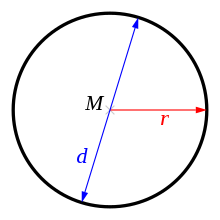Pi
The circle number π 




The circle number does not only occur in geometry, but also has significance in other mathematical subfields and theories. For example, it can be used to link the solution of the classical Basel problem with the theory of Fourier series.

The Greek lowercase letter Pi is the symbol of the circle number.
History of the designation
The circular number and some of its properties were already known in ancient times.
The designation with the Greek letter Pi (

The same terms were used around 1664 by the English mathematician Isaac Barrow.
David Gregory took π
59 years later than Oughtred, in 1706, the Welsh mathematician William Jones was the first to use the lowercase Greek letter π to 
It was not until the 18th century that π 


Definition
Several equivalent approaches exist to define the circle number π .
The first (classical!) definition in geometry is that according to which the circle number is a ratio numerically equal to the quotient π 






In analysis, one often proceeds (after Edmund Landau) to first define the real cosine function 
Questions and Answers
Q: What is the number π?
A: π is a mathematical constant that is the ratio of a circle's circumference to its diameter.
Q: What does this produce?
A: This produces a number, and that number is always the same.
Q: How does this number start?
A: The number starts as 3.141592653589793... and continues without end.
Q: What type of numbers are these?
A: These numbers are called irrational numbers.
Q: What is the diameter of a circle?
A: The diameter of a circle is the largest chord which can be fitted inside it, passing through its center.
Q: What is the circumference of a circle? A: The distance around a circle is known as its circumference.
Q: Does pi remain constant regardless of different circles? A: Yes, pi remains constant regardless of different circles because the relationship between their circumference and diameter always stays the same.
Search within the encyclopedia



